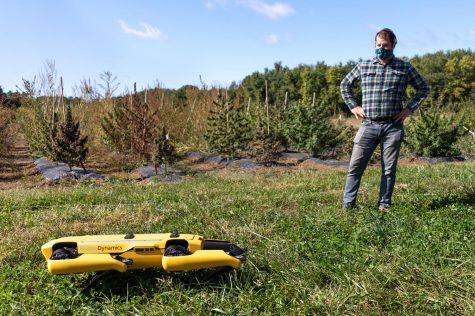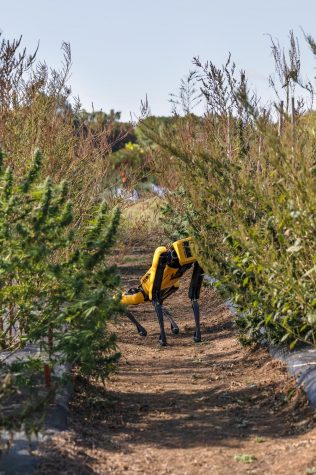Photo of the Day: SIU introduces “SPOT,” an agricultural robot dog
September 29, 2020
The demonstration of SPOT at SIU’s Horticulture Research Center on Tuesday, Sept. 29, was one of the first instances of this technology being used worldwide, Baker said.


“So we use this [SPOT] for biosecurity. The current method for detection [of pathogens] is visual observation. The problem with that is when we see those particular problems, they are extremely pervasive and hard to fix,” Kyle R.L. Baker, Chief Strategy Officer at EcoBuds, said.
Baker said that SPOT’s sensors can detect problems at a microscopic level which can help to detect these problems well before the plants become visually symptomatic. This allows the plants to be treated before even showing symptoms.
Advertisement
It can be controlled remotely or through preloaded missions.
SPOT uses visual AI sensors from Scanit Technologies. Scanit Technologies invented a SporeCam sensor that, “sucks in a volume of air and the air particulates all around us get attached to what is essentially a cassette and a very advanced microscope views that media and classifies the different particulate matters,” Baker said.
Once the sensor collects the different particulate matters, Baker said, “Then it classifies those different particulate matters into botrytis, or powdery mildew, or rust spot, or whatever pathogens it’s trying to look for.”
The sensors are attached to the back of the robot and would have an arm, a gas sensor, the SporeCam, a camera, maybe some LiDAR on the back, and would implement some things such as RFID beacon technology to do track and trace, Baker said.
“We use gas sensors to detect levels of chlorine dioxide or oxygen or CO2 or butane, commonly used gases that could be dangerous to not only the plant but also to people. We want to make sure that we observe that, cause we can’t detect it as humans,” Baker said.
By using different camera technologies, visual AI allows for the capability of looking at the different spectrums of light. This means that if a plant had a disease, the visual AI would be able to see the color variations of the leaves.
Karla Cage, Assistant professor of Weed Science and Plant Biology, said, “We’re looking at how to produce hemp and control the weeds in it so this we’re looking at weed competition with the tall plants that are not hemp.”
Advertisement*
“The goal of my lab is that we have to figure out how to grow this as a crop and then we can do the research that we need to do on it, so we’re looking at some basic agronomy, just the basic factors on how to get it started and get the yield and then the weeds studies are on top of that,” Cage said.
Photo Editor Leah Sutton can be reached at [email protected] or on Twitter at @LeahSutton_
To stay up to date with all your southern Illinois news, follow the Daily Egyptian on Facebook and Twitter.
Advertisement

